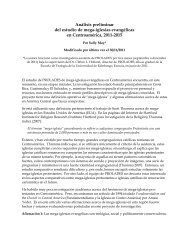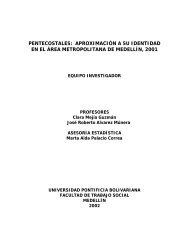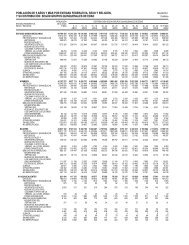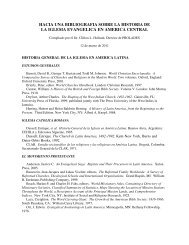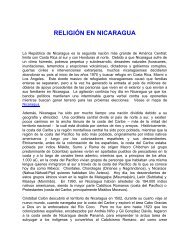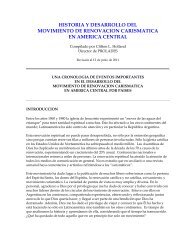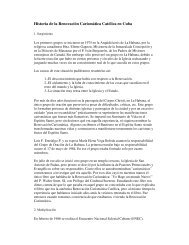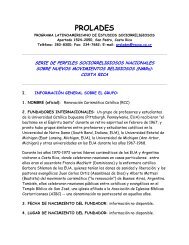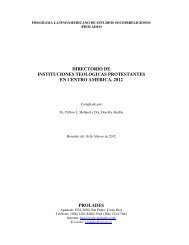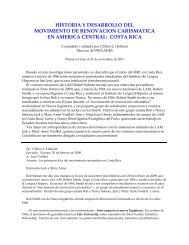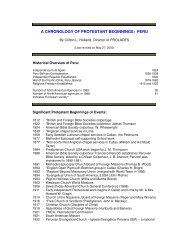Toward a Classification System of Religious Groups ... - Prolades.com
Toward a Classification System of Religious Groups ... - Prolades.com
Toward a Classification System of Religious Groups ... - Prolades.com
You also want an ePaper? Increase the reach of your titles
YUMPU automatically turns print PDFs into web optimized ePapers that Google loves.
A2.100 ROMAN CATHOLIC CHURCH - RCC (First century AD; Vatican City, a<br />
sovereign state in Italy)<br />
Overview: administratively, the RCC is organized into "diocese" (under<br />
the authority <strong>of</strong> a bishop = bishopric), and the largest and most<br />
important are designated "archdiocese" (under the authority <strong>of</strong> an<br />
archbishop = archbishopric); diocese are grouped into provinces, regions<br />
and conferences; since the 1950s USA bishops have been organized into<br />
the National Catholic Conference in the U.S., and in Latin America into<br />
CELAM (Conferencia Episcopal Latinoamericana, 1955); the RCC is the<br />
largest Christian body in the world with churches in nearly every<br />
country:<br />
http://www.vatican.va/phome_en.htm<br />
http://kentaurus.<strong>com</strong>/domine/catholic.htm<br />
A2.200 RELIGIOUS ORDERS<br />
Overview: institutes <strong>of</strong> men and women <strong>of</strong> pontifical right; various<br />
ordered <strong>com</strong>munities formed by priests, nuns and lay brothers and<br />
sisters carry out the work <strong>of</strong> the Church in many countries <strong>of</strong> the world;<br />
whereas in Protestantism dissent and reform <strong>of</strong>ten produce new<br />
"denominations," within Roman Catholicism these creative energies are<br />
<strong>of</strong>ten channeled into new religious movements within the Church <strong>of</strong><br />
Rome; such religious orders <strong>of</strong>ten show all the characteristics <strong>of</strong><br />
sectarian bodies including distinctive liturgy, theology, dress, and social<br />
zeal but tend to remain loyal to the <strong>of</strong>ficials <strong>of</strong> their religious order and to<br />
the Bishop <strong>of</strong> Rome; there are hundreds <strong>of</strong> religious orders within the<br />
RCC; "secular" (or diocesan) priests serve in the diocese and are assigned<br />
to local parishes, but "religious" priests normally carry out their<br />
assignments directly through the <strong>of</strong>ficials <strong>of</strong> their religious orders, as do<br />
nuns and lay brothers and sisters; for more information, see:<br />
http://www.shc.edu/theolibrary/orders.htm<br />
A2.300 AUTONOMOUS ORTHODOX CHURCHES IN COMMUNION WITH THE<br />
VATICAN – THE HOLY SEE<br />
Overview: the autonomous Eastern Orthodox Churches that are in<br />
<strong>com</strong>munion with the Vatican are under the jurisdiction <strong>of</strong> the Pope<br />
through the Congregation for Oriental Churches (created in 1862), one <strong>of</strong><br />
the <strong>of</strong>fices <strong>of</strong> the Roman Curia. The ecclesiastical life <strong>of</strong> the non-Latin<br />
rite churches is governed by the Canonical Code <strong>of</strong> the Eastern Churches<br />
that was pronounced by Pope John Paul II on 18 October 1990 and<br />
became law on 1 October 1991. According to the Oriental Code, the<br />
Eastern Orthodox Churches in <strong>com</strong>munion with the Vatican are<br />
organized under four categories: (1) Patriarchal (Armenian, Chaldean,<br />
Coptic, Maronite, Melchite and Syrian; (2) Major Archepiscopal<br />
(Ukrainian and Syro-Malabarian); (3) Metropolitan sui iuris (Ethiopian,<br />
Romanian, American Ruthenian and Syro-Malankara); and (4) Other sui<br />
21



